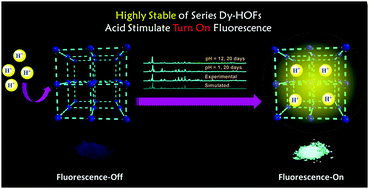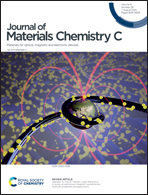Substituents lead to differences in the formation of a series of dysprosium hydrogen-bonded organic frameworks with high stability and acid stimulus–response luminescence properties†
Abstract
Building a hydrogen-bonded organic framework (HOF) that is resistant to strong acids and bases has always been challenging. Especially for lanthanide HOFs with large volume, irregular shape, and weak noncovalent force, their high stability is extremely difficult to achieve. Herein, we have used the reaction of 2-hydroxybenzaldehyde, 5-chloro-2-hydroxybenzaldehyde, 5-bromo-2-hydroxybenzaldehyde, 2-hydroxy-5-methylbenzaldehyde, and 5-fluoro-2-hydroxybenzaldehyde with 2,2-dimethylpropane-1,3-diamine and DyCl3·6H2O under room temperature conditions to obtain five Dy–HOFs [Dy(L1−R)(L2−R)]n (R = H (1), Cl (2), Br (3), CH3 (4), F (5)). Notably, the above Dy–HOFs are immersed in solutions with different pH values (1–13) for 20 days and maintain a high degree of stability. Moreover, the solid-state fluorescence of Dy–HOF samples immersed under acidic conditions has a “turn-on” response, and the solid-state fluorescence increases with increased acidity. This study is the first to investigate a series of highly stable metal–HOFs that is constructed by adjusting the substituents on the ligand, and the acid-responsive “turn-on” solid-state fluorescence of metal HOFs is reported for the first time. The anti-counterfeiting test results show that the ink made from the samples before and after the acid treatment can achieve dual anti-counterfeiting properties under sunlight and ultraviolet light. In addition, the ion sensing experiment also shows that the sample solution soaked in acid can specifically recognize Pb(II) ions. Magnetic research shows that all Dy–HOFs show obvious frequency-dependent behavior under zero field conditions, while 1, 4 and 5 show obvious single-molecule magnet behavior.



 Please wait while we load your content...
Please wait while we load your content...